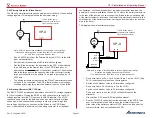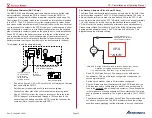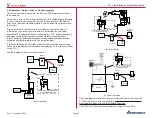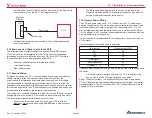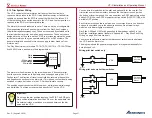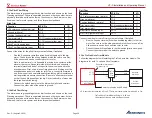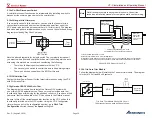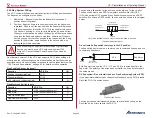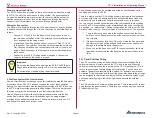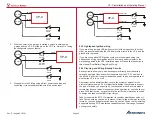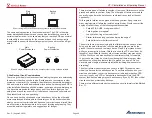
Page 31
VP-X Installation and Operating Manual
Rev. D (August 5, 2020)
5.9b Primary Alternator (Plane Power)
The Plane Power alternator requires a single wire for the field. It has a built-in
voltage regulator. This diagram shows the alternator wiring:
J12-11
F
B
20A
WG
PRI
ALT
ANL
To PPS B-lead post, or
alternatively, the switched
side of battery contactor
VP-X
Note: ANL is a type of fuse available in various high-current ratings.
It requires a mounting base and the fuse itself. Try a web search
for “ANL fuse” or go to www.bandc.com
•
Run a 20 AWG wire from the Primary Alt circuit (J12-11) to the field
input on the alternator.
•
Set the circuit breaker value to 5A later when configured.
• Run the B-lead wire from the alternator to the PPS, or alternatively
to an ANL fuse on the firewall, then to the PPS B-lead post, or
alternatively the switched side of the battery contactor. The switched
side is the large post on the opposite side of the contactor from the
large post connected to the battery. The b-lead is typically a 6 or 8
AWG wire.
• The alternator failure wire/output on the Plane Power alternator does
not need to be connected. The EFIS will alarm when a low voltage
condition exists, signifying that the alternator is not on or has failed.
5.9c Backup Alternator (B&C 20 Amp)
The B&C SD-20 20 amp backup alternator uses the LR-3C voltage regulator
for 14 volt systems. If using the SD-20 on a 28 volt system, use the LS-1A
voltage regulator from B&C. Do not use the SB1B regulator. The LR-3C
requires a power wire for the field as well as a power wire for the voltage
sense wire, which senses the bus voltage in order to correctly regulate
bus voltage.
Note that you can connect the B-lead to the PPS B-lead
post, or alternatively to either side of the battery contactor.
In a traditional
configuration, use the switched side of the battery contactor (same as the
primary alt). In some installations like an RV-10 where the battery contactor is
in the rear of the aircraft, you can connect the B-lead to the un-switched side
of the starter contactor, located on the firewall (it is electrically identical to the
switched side of the battery contactor, saving you from having to run another
wire to the back).
This diagram shows the alternator wiring:
F
20AWG
5A 2A
22AWG
20A
WG
B&C LR-3
Volt Reg
Pin
FLD 4
Bus 6
V Sense 3
GND 7
B&C
SD-20
ALT
B
ANL
To PPS B-lead post, or
alternatively, the switched
side of battery contactor
VP-X
Note: ANL is a type of fuse available in various high-current ratings.
It requires a mounting base and the fuse itself.
Try a web search for “ANL fuse” or go to www.bandc.com
• Run a wire from any 2A, 3A or 5A circuit to pin 3 on the LR-3C. (See
LS-1A instructions for pin outs on that regulator)
•
Set the circuit breaker value to 2A later when configured.
• Run a wire from a 5A circuit to pin 6 on the LR-3C.
•
Set the circuit breaker value to 5A later when configured.
•
Run a wire from pin 4 on the LR-3C to the field input on the
alternator.
• Ground the LR-3C as per B&C installation manual.
• Run the 12 AWG B-lead wire from the alternator to the PPS B-lead
post, or alternatively to an ANL fuse on the firewall, then to the
either side of the battery contactor. NOTE: locate the fuse near the
contactor (Note: fuse not required with PPS).















